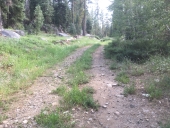
 4
4




 6
6




“The most important decision we make is whether we believe we live in a friendly or hostile universe.”― Albert Einstein
 4
4




Fish heads fish heads roly poly fish heads
 2
2




Dan Fish wrote:Rocking the sides will work too. The rock will fill in with mud but it will hold way better than just clay. Sloping your ditch sides as mellow as you can will help. Shoot, I would do both seeding and rock.
 4
4




Fish heads fish heads roly poly fish heads
 1
1




Fish heads fish heads roly poly fish heads
How to post pictures: https://permies.com/wiki/61133/Post-Image-Permies
How to do other stuff: https://permies.com/w/how-permies-works
If you have trouble editing the post to add the picture, hit the report button, as editing sometimes doesn't work without staff pushing a button.
 2
2




Invasive plants are Earth's way of insisting we notice her medicines. Stephen Herrod Buhner
Everyone learns what works by learning what doesn't work. Stephen Herrod Buhner
 1
1




Dan Fish wrote:Hmmm yeah that round rock won't work as well as easier stacking rock. I would think it's better than nothing though, for sure, I mean this isn't a stream bed, just an almost flat drainage ditch, right? If you use the round rock just start with the biggest on the bottom and stack it up the sides as best you can. If you can, "cap" it with big heavy rocks too. This sort of holds the rock in place. I think shaping the rock would work great and look awesome but that sounds like a lot of work.
Here is a picture of what I was originally thinking:

 4
4





 4
4




Fish heads fish heads roly poly fish heads
 2
2




Joseph Lofthouse wrote:I would build gently raised beds. By that I mean digging lower areas, and tossing the dirt into mounds on which the trees can grow.
Soil constantly fills in low lying areas where water doesn't carry the sediment away, so routine maintenance would include removing soil from the low lying areas, and depositing it onto the mounts.
I envision something like this...
 1
1




Dan Fish wrote:Hi Bernie,
If you do buy your rock don't get drain rock. It is round rock for maximum airspace. So it won't stack well or hold much back, comparatively. What you want is something like:
4" rock. It's jagged and will interlock well., Really it's for road surfacing but I would think it would work good for a 12" deep ditch. There are many grades from "minus" (Basically what falls through a 4" sieve at the gravel plant, so lots of smaller pieces) to "washed" (only rocks about 4 inches).
Rip-Rap. This is larger angular rock that is great for holding up a slope. It's pretty big though.
So if it was me I would probably go in between the two. Go to your local gravel yard and they ought to have buckets of samples out front and then you can decide what will work for you. Or a landscape yard will have some of the same stuff and maybe more aesthetically pleasing too.
Rock is cheap but the delivery is a killer.
HOWEVER, I have my trees that are in heavy, undraining clay in a system very much like Jo-Lo up there. It works well.

|
Story like this gets better after being told a few times. Or maybe it's just a tiny ad:
Learn Permaculture through a little hard work
https://wheaton-labs.com/bootcamp
|


